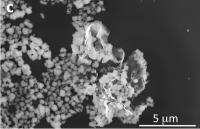A University of Arizona and Rensselaer Polytechnic Institute research team has boosted the toughness of ceramic composites with graphene reinforcements to facilitate ceramic fracture resistance.
 Arizona's Gaphene Nanocomposites
Arizona's Gaphene Nanocomposites
Assistant professor Erica L. Corral from the Materials Science and Engineering Department at the University of Arizona in Tucson, and professor Nikhil Koratkar from the Department of Mechanical, Aerospace and Nuclear Engineering at Rensselaer Polytechnic Institute in Troy, New York, jointly led the team, which has discovered that graphene could stop the crack from spreading and force it to change course in two and three-dimensions. The large surface area and two-dimensional graphene sheet structure helps check cracks spreading in ceramics.
The team synthesized large quantities of graphene platelets using ceramic composite fabrication and testing technology developed at the University. Grapheme strengthens ceramic that is hard and brittle making it susceptible to fractures, so this research could exploit graphene ceramic nanocomposites for further research. The nanocomposite resistance fracture is enhanced by more than 200% and could increase the toughness of multiple ceramic products used in structural applications that operate at more than 1000°C.
The research report titled Toughening in Graphene Ceramic Composites, that appeared in ACS Nano, an American Chemical Society monthly journal, has been co-authored by Luke S. Walker, Victoria R. Marotto and Erica L. Corral of the University of Arizona; and Mohammad A. Rafiee and Nikhil Koratkar of the Rensselaer Polytechnic Institute. The research was conducted with grants from the State of Arizona, the U.S. Office of Naval Research and the U.S. National Science Foundation Early Faculty Career Award.